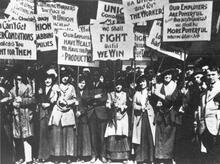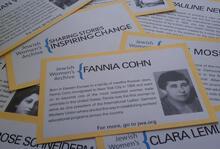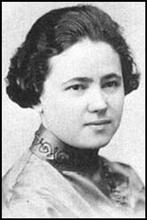Working Women's Education in the United States
The garment industry, with its poor working conditions and oppressive leadership, was the perfect place for working women to form organizations in which they could educate themselves. Although young immigrant Jewish women had always been motivated to become educated and made up a significant proportion of New York City public school students, the workers’ education movement in the 1910s and 1920s tried to teach workers to develop a sense of class consciousness and a desire to promote social justice. The International Ladies Garment Workers Union in particular was a leader in the movement. These organizations created summer schools at colleges and universities to educate women workers about trade unionism.
Background
In the early twentieth century, young Jewish Eastern European immigrant women needed to work but wanted to learn as well. Expected to work until they married, Jewish daughters wanted an education to advance themselves economically and to take advantage of opportunities denied them in the Old Country. Jewish women formed a high proportion of students in evening schools, settlement houses, and vocational training courses that taught them to be more proficient workers, to speak better English, and to be more American.
Jewish working women also served as the leaders and members of the largest attempt to educate women as workers, the workers’ education movement. Begun by the predominantly Jewish International Ladies Garment Workers Union (ILGWU) in the 1910s and continued by other union leaders and reformers, workers’ education programs taught workers to develop a sense of class consciousness and a desire to promote social justice. Organizers designed these programs specifically for the needs of women workers but always allied with the labor movement over feminism when forced to choose. This article discusses the many types of education Jewish working women received, focusing on the 1910s through the 1930s, the height of the workers’ education movement in the United States.
Mostly single Jewish women sought education. Married women, with dual responsibility for the household and family income, tended not to take advantage of educational opportunities. Once a Jewish woman married, she generally stopped working outside the home. As in Eastern Europe, married women contributed to the family income by taking in boarders, helping in their husbands’ businesses, or sewing and finishing garments in the home.
While Jewish families expected married women to stay at home, they expected their single daughters to work to supplement family income, to keep brothers in school, and to bring over relatives from the Old Country. Although they worked in a variety of trades, most Jewish women spent some part of their young adult life working with a needle and thread. In 1900, 53.6 percent of all employed Jewish women in New York City worked in the garment industry.
The Garment Industry
Conditions in both garment sweatshops and factories were bad. In sweatshops, the contractor, usually a slightly more established immigrant, obtained precut, unsewn garments from the manufacturer. The contractor either supervised basting, pressing, finishing, zipper installing, buttonhole making, and pocket making himself, or gave some of the work to a subcontractor, who then gave that work to people to finish at home. This system encouraged exploitation. Workers labored in crowded sweatshops for long hours. Contractors had small profit margins and so paid their sweatshop workers low wages. In addition, the system created a vicious cycle: Immigrants became contractors whenever possible; they competed with former employers by offering lower bids and speedier deliveries; and they exploited the latest group of newcomers.
Factories, or “inside shops,” were not much better than sweatshops. Frequent speedups; dangerous work; fees for needles, irons, lockers, chairs, and electric power to run machines; and fines for damaging garments, breaking needles, and arriving late all made for miserable work conditions.
Even though young Jewish immigrant women in the early twentieth century worked in demanding jobs, they reserved time and energy for education. Why? What did they expect in terms of education? Women who immigrated as teenagers knew how to read and write because Jewish culture considered such skills acceptable for girls. In the United States, these young women grabbed opportunities for education newly available to them in such a way that they could continue to work. Unlike in the Old Country, education in America was compulsory and free. Even poor girls could attend high school. However, economic realities dictated that many immigrant girls left school for full-time jobs as young as nine or ten. In 1914, the New York State Factory Investigating Commission reported that 75 percent of women working in factories had left school before completing the eighth grade.
For most girls, learning job skills was the first priority. Many had to attend evening school because they worked during the day. The New York City Board of Education, the Industrial School for Girls, and the Educational Alliance offered vocational courses in dressmaking, sewing, and hat trimming, among other subjects. Jewish girls already proficient in English sometimes took typing or bookkeeping courses to obtain coveted office positions. In addition to vocational training, settlement houses such as the Educational Alliance offered classes in English and Yiddish on history, literature, religion, music, art, hygiene, “virtue,” and American nationalism.
By 1898, New York City’s Board of Education ran sixty-one elementary schools and four high schools in the evening. By 1906, Jews constituted the majority of students enrolled in elementary, high school, and Americanization classes in New York City, and the Board of Education sponsored lectures in Yiddish. Forty percent of the Jewish students were female. However, earning a high school degree at night was very difficult for working women, who lacked the time and energy for the advanced classes, which met for five three-hour sessions weekly. Despite registering in large numbers, Jewish girls attended high school classes only sporadically. Still, the high proportion of Jewish women in the evening school system shows their avid desire for learning and economic advancement.
While public schools and settlement houses offered vocational training and academic courses, workers’ education programs also attempted to teach women workers about social activism. In the 1910s and 1920s, the workers’ education movement tried simultaneously to convince workers of the need to build a new and better social order and to moderate their more radical impulses by instructing workers on the principles of trade union participation and leadership. Many of the middle-class intellectuals, radicals, and reformers who started the movement and many of the workers who benefited from it were Jewish women.
The 1910s to the Early 1920s
The workers’ education movement began in 1915, when Juliet Stuart Poyntz, a middle-class, non-Jewish, college-educated midwesterner, established the first unity house in the Catskills to serve as a vacation house for members of the ILGWU Local 25. Poyntz went on to organize unity centers at local public schools, where workers could attend union meetings and take courses in English and physical education. Inspired by these activities, the ILGWU created a national education department in 1916.
Before Poyntz resigned in 1918, she directed the ILGWU’s education department. The ILGWU opened more unity houses and unity centers and established the Workers’ University at Washington Irving High School in New York City. At this university, workers took classes in American history and government, labor problems, economics, literature, and psychology; these classes continued well into the 1970s.
The education department was to act as both a radical and a moderating influence on its workers. It aimed to “enlighten our members upon all matters concerning labor and make of them a well-disciplined and reliable body of men and women, who cannot be misled and incited by anybody who desires to do so.” The ILGWU wanted to teach the responsibilities and duties of unionism and express its deep commitment to social unionism, a philosophy that connected the growth of a union to the building of a new social order in which workers’ economic, social, and spiritual needs would be fulfilled. According to social unionism, workers needed higher wages and shorter hours, but they also needed education, health care, housing, and recreation. This philosophy had practical benefits: If a union met its members’ needs, then members would feel more loyalty to the union.
The most urgent of the immigrant workers’ needs was for education. Fannia Cohn, a Russian Jewish immigrant who replaced Poyntz, believed that age, lack of formal schooling, or class should not deprive workers of a liberal education. At the Workers’ University, workers studied art, literature, philosophy, or history on the weekends from the same professors who lectured to the upper classes at Columbia University during the week. The ILGWU’s education department arranged for New York City public school teachers to teach reading, writing, and arithmetic to workers at night and on the weekends.
Cohn, who had worked in a garment factory despite her middle-class background, argued that workers’ education would make for a stronger union. While “individual education” inculcated students with individualistic values and “Knowledge for Knowledge’s sake,” workers’ education, Cohn explained, inspired workers to serve the labor movement. The ILGWU’s curriculum, while including a wide variety of course offerings, reflected Cohn’s goals.
For example, in the early 1920s, the Workers’ University offered more classes in trade union history, political science, and economics than in music, literature, art, and remedial subjects. The ILGWU workers’ education program was to enable immigrant workers to restructure American society through a greater awareness of society’s problems and possible solutions.
In addition to teaching their worker-pupils how to remake the social order, Cohn and Poyntz recognized that women workers wanted a place to have fun. To the many women who had thought of trade unions as a group of middle-aged men smoking, drinking, and arguing, the unity center offered an alternative—a comfortable place for women. At a unity center, women workers could take courses, attend shop meetings, or enjoy a cup of coffee with friends. Thus, workers’ education programs provided women not only with an education in economic justice but also a sense of community.
After World War I, the lofty goal of the ILGWU to create a new social order through education seemed within reach. The Russian Revolution, revolts in Germany and Eastern Europe, the rise of the British Labour Party, and the wave of strikes across the United States in 1919 all gave hope to and helped nourish the workers’ education movement. Beginning in 1921, several colleges opened summer schools for women workers. The ILGWU’s education department and its Jewish members played an important role in the development of all of these institutions.
Like the ILGWU’s education department, the summer schools wanted workers to learn the principles of trade unionism. Unlike the ILGWU, they also aimed to teach women workers to be union leaders by removing them from their jobs for a period of weeks or even months to receive intensive education in trade union history, politics, and economics. Several hundred women workers gave up pay and risked losing their jobs to attend these summer schools, located on college campuses or in quiet country homes. These schools had a precursor: the Women’s Trade Union League’s Training School for Women Organizers. Although it lasted only from 1914 to 1926 and educated a small number of students, this Chicago-based school succeeded in its goal of training young women for leadership positions in the union movement through several months of academic work and then several of fieldwork. Fannia Cohn was a member of the school’s first class.
The Women’s Trade Union League sponsored the first summer school at Bryn Mawr College in 1921. Each summer until 1938, at least sixty staunch union women spent about seven weeks at the Bryn Mawr Summer School for Women Workers. A preponderance of students were Russian Jewish immigrants. One notable Jewish graduate of the school was Rose Pesotta, who became a leading trade unionist in the 1930s and 1940s and the only woman vice president of the ILGWU’s executive board. The school encouraged participation and discussion and expected the students to take knowledge of critical thinking back to their fellow workers and lead working women to change their lives.
Other residential summer schools followed. The Barnard College Summer School, the Summer School for Workers of the University of Wisconsin, and the Southern Summer School all began in the mid-1920s. These schools formed a coordinating body for workers’ education programs for women, the Affiliated Schools for Women Workers, in 1928. Students generally appreciated the summer schools. They enjoyed uninterrupted freedom to learn and, as alumnae, stated that the understanding stimulated at the schools led them to various types of labor and union activities. Former students developed workers’ education programs in their local areas and promoted better working conditions for women by speaking out on issues such as labor standards, unemployment insurance, and labor legislation. Alumnae expressed a few complaints: Several were disappointed about the lack of courses in socialist theory, and others noted the ironic difference between the tranquil campus and their daily working lives.
In 1921, the ILGWU and Cohn established Brookwood College, the first coeducational labor college in the United States, in Katonah, New York. As with other workers’ education programs, Brookwood classes, especially in the social sciences, helped students to understand societal problems and encouraged them to go back to the shops to disseminate their new knowledge. Also in 1921, Cohn helped found the Workers’ Education Bureau to coordinate workers’ education programs and activities and develop a philosophy of workers’ education.
Most women who led the workers’ education programs, such as Fannia Cohn, rejected the label of feminist. They argued that they were not trying primarily to improve the status of women but instead to reform working conditions within industrial society. Yet, they worked specifically to improve women’s lives and felt that a better society would not allow women to be victims of long hours, low wages, and poor working conditions. Like the prominent women of the New Deal, the women leaders of the workers’ education movement were social feminists who believed that women had a special role to play in creating a more just society, rather than feminists who believed in equal rights for women.
The Mid-1920s to 1930s
In many ways, workers’ education was an enormous success. Shaped in large part by Jewish women, the movement prepared a generation of women trained in the principles of trade unionism. Many of these women moved into union leadership and demanded improvements in working conditions. When, in the late 1930s, the Congress of Industrial Organizations made efforts to organize women, it found ready support from women schooled in workers’ education.
However, by the mid-1920s, the ILGWU’s education department began to decline. Automation, seasonal unemployment, and stagnant wages and benefits hurt the ILGWU. Employers waged campaigns against the unions, and within unions communists and socialists competed bitterly for control. Finally, young workers became increasingly concerned with acquiring the contraptions of consumer culture rather than with saving society through workers’ education. The ILGWU and its education department revived during the New Deal but in a different form.
The ILGWU’s new workers’ education, known by the 1930s as “labor education,” dismissed the special concern for women workers developed and nurtured by Fannia Cohn and Juliet Poyntz and instead focused only on creating good union members. The 1930s education department no longer paid attention to workers’ economic, social, and spiritual needs. It taught workers to serve the union, not to remake the social order. In addition to transforming the education department, the changing political tides of the 1930s forced the closing of two other major enterprises in workers’ education, Brookwood Labor College, and the Bryn Mawr Summer School.
At the beginning of the twentieth century, young Jewish working women flocked to evening school, vocational training courses, and settlement house programs, hoping to learn more than had been permitted to them in Eastern Europe. Immigrant daughters also led the way in a unique experiment in education, the workers’ education movement. This movement drew Jewish working women as leaders and participants because of its commitment to learning, social justice, and social feminism. Angered by their working conditions, young Jewish women sought education, which they believed would help them to improve their own lives and to remake the world.
Altenbaugh, Richard J. Education for Struggle: The American Labor Colleges of the 1920s and 1930s (1990).
Baum, Charlotte, Paula Hyman, and Sonya Michel. The Jewish Woman in America (1976).
Brumberg, Stephan F. Going to America, Going to School: The Jewish Immigrant Public School Encounter in Turn-of-the-Century New York City (1986).
Bryn Mawr School for Women Workers. Papers. Institute of Management and Labor Relations, Rutgers University, New Brunswick, N.J.
Cohn, Fannia. Collection. New York Public Library, NYC; Feingold, Henry L. A Time for Searching: Entering the Mainstream, 1920–1945 (1992).
Glenn, Susan A. Daughters of the Shtetl: Life and Labor in the Immigrant Generation (1990).
Hill, Helen D. The Effect of the Bryn Mawr Summer School as Measured in the Activities of Its Students (1929).
Kessler-Harris, Alice. “Organizing the Unorganizable: Three Jewish Women and Their Union.” Labor History 17, no. 1 (Winter 1976): 5–23.
Kessler-Harris, Alice. Out to Work: A History of Wage-Earning Women in the United States (1982).
Smith, Hilda W. Collection. Schlesinger Library, Radcliffe College, Cambridge, Mass.
Sorin, Gerald. A Time for Building: The Third Migration, 1880–1920 (1992).
Starr, Mark and Helen. Collection. Archives of Labor and Urban Affairs, Brookwood Labor College, Wayne State University, Detroit, Mich.
Tamiment Library. New York University, NYC.
Weinberg, Sydney Stahl. The World of Our Mothers: The Lives of Jewish Immigrant Women (1988).
The Women of Summer. Film. (1975).
Wong, Susan Stone. “From Soul to Strawberries: The International Ladies’ Garment Workers’ Union and Workers’ Education, 1914–1950.” In Sisterhood and Solidarity: Workers’ Education for Women, 1914–1984, edited by Joyce L. Kornbluh and Mary Frederickson (1984).









